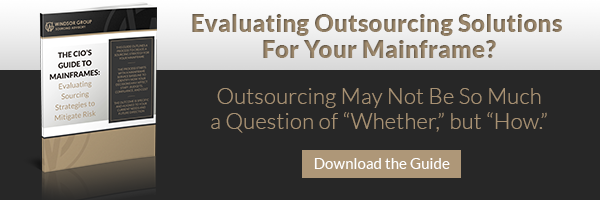.jpg) Maybe your policy up till now has been to avoid mainframe outsourcing, but it’s getting harder to justify that. Your costs continue to rise and the twin risks of legacy system obsolescence and retiring mainframe pros are growing more pressing with each passing day. Not to mention the rapidly increasing size and complexity of your company’s IT workload. It’s time to reassess that policy of avoidance.
Maybe your policy up till now has been to avoid mainframe outsourcing, but it’s getting harder to justify that. Your costs continue to rise and the twin risks of legacy system obsolescence and retiring mainframe pros are growing more pressing with each passing day. Not to mention the rapidly increasing size and complexity of your company’s IT workload. It’s time to reassess that policy of avoidance.
Even for companies that have chosen mainframe outsourcing, results aren’t always rosy. All that work to choose and implement a transformative solution, just to feel as if it’s slipping through the cracks. That can happen when you’re so focused on the technical details – tailoring a functional solution you thought would serve your internal workings and your customers well – that you overlook or ignore other key success factors. Those omissions can come back to haunt you.
Mainframe outsourcing can be highly advantageous, but only if you approach it holistically. So let’s review some of those key success factors. What could go wrong?
You chose the wrong solution.
If you didn’t conduct a thorough, accurate self-assessment as a first step in your mainframe outsourcing planning process, you set yourself up for a “solution” that’s off-kilter. Even if you’re getting by right now, you won’t have the scalability or flexibility you need down the road.
The right solution is likely to be a hybridized configuration that looks beyond your immediate needs to help achieve long-term enterprise goals. If you decide to retain some functions in-house, be sure you know why you’re making that choice.
You chose the wrong vendor.
You need someone with the specific talents and expertise to manage your mainframe outsourcing solution effectively. But how you work together to take maximum advantage of their expertise matters, too. Will they provide extra consulting services? Do you want them to partner with you on new IT product development?
And how’s that relationship going? Perhaps you didn’t realize that the #1 cause of mainframe outsourcing failure is inability to work together smoothly, so you didn’t consider those “fluffy” details such as whether you actually liked and trusted your vendor’s people. You know that teams whose members don’t mesh don’t produce good results. And as a related personnel issue, did you lay the proper groundwork so your remaining in-house IT staff understand and support the transformation?
Costs are coming in higher than projected.
Either you overlooked hidden costs when you computed total cost of ownership of your mainframe outsourcing plan, or your provider’s pricing structure is out of alignment with services.
Who’s in charge here, anyway?
If you feel you’re still spending too much time managing mainframe operations, or if you feel as if you’ve lost control altogether, that can be a worrisome time-waster. Unclear expectations lead to duplication of effort, meddling, miscommunication and a host of other issues that indicate a lack of trust. Eliminate finger-pointing by creating appropriately detailed SLAs and key performance indicators that directly reflect your objectives.
Your exit strategy is sketchy.
One hates to contemplate divorce as the marriage vows are being spoken, but you have to be realistic. While you hope mainframe outsourcing will bring you a long-term partnership, your contract will last only two or three years at most. Then it will be time to renew. Or not. And if things don’t always work out mid-stream, you’ll want an out that allows both you and your vendor to regroup and move forward. This is just good business.
If you have to worry about why your expectations aren’t being met or wonder if they will be, you haven’t freed yourself to concentrate on the core responsibilities of growing your enterprise. Clearly delineating expectations – yours and theirs – well-chosen performance metrics that you actually analyze regularly, and effective ongoing communication are key success factors, no matter what solution you design or what provider you choose.


